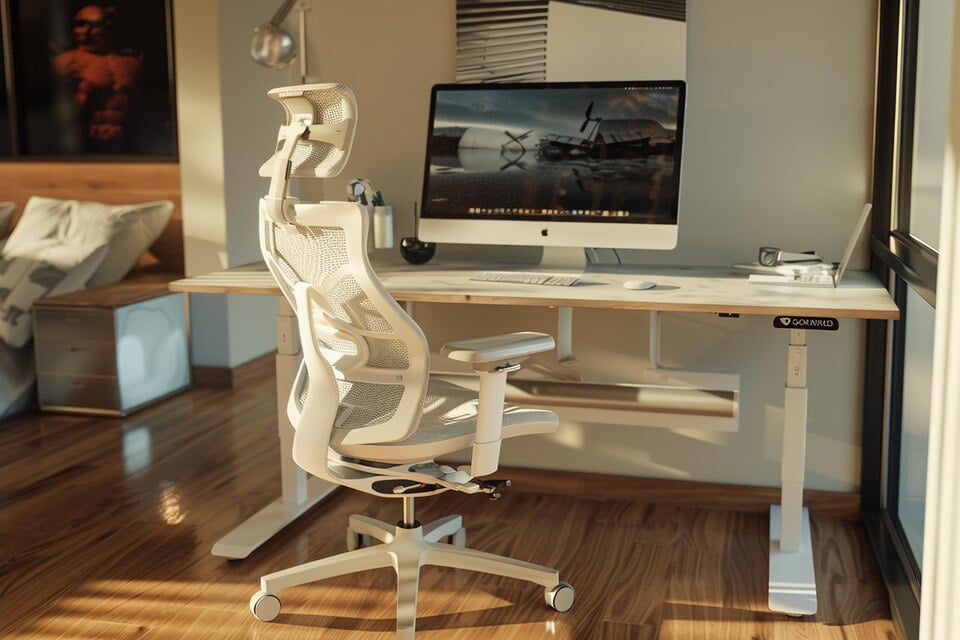Do you spend the majority of your workday sitting at a desk? If so, you may have experienced discomfort, pain, or even developed musculoskeletal disorders. The good news is that there are solutions to these problems. Ergonomic office furniture is designed to enhance your workspace, improve your health, and increase your productivity. By incorporating ergonomic office furniture into your workplace, you can minimize the risk of injury, reduce stress on your body, and create a healthier work environment overall.
In this article, we will explore the benefits of ergonomic office furniture, and provide tips on choosing the right ergonomic office chair, standing desk, ergonomic keyboard, adjustable desk, ergonomic computer mouse, and more. We will also discuss how office ergonomics training and workstation setup can contribute to a more comfortable and efficient work environment.
Investing in ergonomic office furniture is an investment in your health and well-being, and it pays off in terms of increased productivity and job satisfaction. Join us as we explore the world of ergonomic office solutions!

Benefits of Ergonomic Office Furniture
Investing in ergonomic office furniture can provide many benefits for both employees and employers. Here are a few key advantages:
- Improved Comfort: Ergonomic office chairs and desks are designed to fit the body’s natural contours, reducing discomfort and fatigue.
- Reduced Risk of Musculoskeletal Disorders: Ergonomic furniture can minimize the risk of developing conditions such as back pain, carpal tunnel syndrome, and tendinitis.
- Increased Productivity: Comfortable employees are more productive, and ergonomics can help reduce distractions and improve focus.
- Promotes Better Posture: Ergonomic furniture promotes good posture, reducing strain on muscles and joints and minimizing the risk of developing posture-related conditions.
Overall, investing in ergonomic office furniture is a smart decision that can benefit both employees and employers.
Choosing the Right Ergonomic Office Chair
Choosing the right ergonomic office chair is crucial in promoting good posture and preventing musculoskeletal disorders. To ensure that you select the right chair for your workspace, consider the following:
- Lumbar Support: Look for a chair that offers ample support for your lower back. This support should be adjustable to accommodate different body types.
- Adjustable Features: Your chair should be adjustable in terms of height, armrests, and backrest. This adjustability allows you to customize the chair to fit your body, preventing strain and discomfort.
- Comfortable Cushioning: Your chair should have adequate cushioning to support your weight and prevent pressure points. Look for a seat with a waterfall edge to reduce pressure on your legs.
- Mobility: Ensure your chair can move easily on its casters without causing damage to your flooring or carpet.
- Durability: Invest in a chair made of sturdy, durable materials. Ensure the chair can withstand regular use, and avoid chairs with flimsy components.
By carefully selecting the right ergonomic office chair, you can improve comfort and prevent discomfort and pain. Take the time to find a chair that meets your needs, and you’ll be rewarded with improved posture and productivity.

The Importance of Standing Desks in Ergonomic Workstations
When it comes to creating a healthy and productive work environment, standing desks have become increasingly popular. Not only do they promote proper posture, but they also offer numerous health benefits. Research has shown that using a standing desk can alleviate back pain, improve circulation, and even boost energy levels.
Standing also encourages movement, which can combat the negative effects of sedentary behavior. If you spend a lot of time sitting at your desk, incorporating a standing desk into your ergonomic workstation can be an excellent way to enhance your overall well-being.
Many standing desks are adjustable, allowing you to switch between sitting and standing positions throughout the day. This variety can improve comfort and reduce the risk of musculoskeletal disorders such as carpal tunnel syndrome and neck strain. With the ability to customize your workstation to your body’s needs, using a standing desk can improve not only your physical health but also your productivity and focus.
Maximizing Comfort with Ergonomic Keyboards
When it comes to working in an office, comfortable equipment can make a big difference. One of the most essential components for maximizing comfort in the workplace is the keyboard. Ergonomic keyboards are designed specifically to reduce strain on the hands and wrists, thereby preventing repetitive strain injuries (RSI). These specialized keyboards feature a curved shape, allowing your wrists to remain in a more natural position while typing. This design reduces the stress on your hands and wrists, reducing the risk of developing RSI.
Additionally, ergonomic keyboards have a split keyboard design, meaning that they are divided down the middle. This unique shape allows you to position your hands in a more natural, comfortable position, rather than forcing them to squeeze together on a standard keyboard. The keys on an ergonomic keyboard are also softer and more responsive, requiring less effort to press and reducing the impact on your fingers.
Investing in an ergonomic keyboard can provide a significant boost to your comfort levels while working. It reduces the stress on your hands and wrist, preventing the development of RSI in the long term. Ensure you choose one to suit your specific needs and comfort for maximum productivity.
The Benefits of Adjustable Desks in Ergonomic Workspaces
If you spend most of your day sitting at work, it’s important to know that sitting for long periods can cause various health issues. Adjustable desks can help you avoid these issues, making them a great addition to any ergonomic workspace.
One of the major benefits of adjustable desks is that they promote movement while working. You can easily switch from sitting to standing positions, which encourages blood flow and reduces the risk of developing health concerns such as obesity and heart disease.
Additionally, adjustable desks allow for proper ergonomic positioning. You can adjust the height of your desk to suit your specific needs, maintaining a comfortable and supportive posture. This reduces the risk of developing musculoskeletal disorders such as lower back pain and tendinitis.
Lastly, adjustable desks prevent sedentary behavior, which can lead to poor health outcomes. Studies have shown that too much sitting can cause health complications such as metabolic disease, increased blood pressure, and elevated cholesterol levels. By having an option to stand while working, you can reduce the amount of time you spend sitting and improve your overall health.
In short, incorporating adjustable desks into your ergonomic workspace can offer numerous benefits, such as promoting movement, improving posture, and reducing sedentary behavior. So, consider investing in an adjustable desk for a healthier and more comfortable work environment.

Benefits of Using an Ergonomic Computer Mouse
If you spend a lot of time on the computer, using a mouse that’s comfortable and easy to use can make a huge difference. An ergonomic computer mouse is designed with your comfort in mind and can offer several benefits over a traditional mouse.
Reduced Strain on the Wrist and Forearm
One of the biggest benefits of using an ergonomic computer mouse is that it can significantly reduce strain on your wrist and forearm. Traditional computer mice require you to grip them tightly and move your arm, which can lead to pain and discomfort over time. An ergonomic mouse is designed to fit the natural curvature of your hand, allowing you to use it with a relaxed grip and minimal arm movement.
Better Comfort and Precision
Ergonomic computer mice are also designed for better overall comfort, with features such as soft-touch materials and contoured shapes. This can help prevent hand fatigue and allow you to work for longer periods without discomfort. Additionally, many ergonomic mice offer better precision and control over traditional mice, with customizable settings and extra buttons for increased functionality.
Improved Productivity and Performance
Using an ergonomic computer mouse can also help improve your productivity and performance at work. By reducing wrist and forearm strain, you’ll be able to work more comfortably and with less distraction. This can result in faster and more accurate work, leading to better overall performance and output.
Investing in an ergonomic computer mouse is a smart choice for anyone who spends a lot of time on the computer. With its many benefits, you can enjoy improved comfort, precision, and productivity, as well as reduced risk of pain and injury.
Creating an Ergonomic Workspace Design
When designing an ergonomic workspace, you must focus on the needs of your employees. A proper ergonomic workspace design can help reduce stress and discomfort, increase productivity, and prevent work-related injuries. Here are some essential tips to help you create an ergonomic workspace design:
Proper Monitor Positioning
Your monitor should be placed at eye level and a distance of about an arm’s length away. This position will help prevent neck strain and improve your posture.
Adjustable Desk Height
Adjustable desk height can help provide more comfort, support, and flexibility for employees. It allows them to switch between sitting and standing, which can improve circulation and productivity.
Proper Lighting
Good lighting is essential in any workspace. It helps reduce eyestrain and enhances visibility. Ensure that your workspace is well-lit and free from glare.
Ergonomic Office Tools
Using ergonomic office tools such as chairs, keyboards, and mice can help prevent work-related injuries such as carpal tunnel syndrome. Ensure that you have the right tools that provide adequate support to your employees.
Creating an ergonomic workspace design is not a one-time task. It is an ongoing process that requires regular evaluations and adjustments. By creating a healthy and comfortable work environment, you are investing in the well-being and productivity of your employees.
Enhancing Ergonomics with Office Accessories
When it comes to creating a healthy and comfortable workspace, the right office accessories can make all the difference.
Ergonomic office accessories such as mousepads, wrist rests, and monitor stands are designed to enhance ergonomics and promote proper posture while you work.
The Benefits of Ergonomic Mousepads
Ergonomic mousepads provide increased comfort and support for your wrist and forearm, reducing the risk of repetitive strain injuries. Look for a mousepad that offers a cushioned surface and a non-slip base.
Using Wrist Rests for Maximum Comfort
Wrist rests are designed to reduce tension and pressure on your wrists while typing, promoting a more natural wrist position. Pair these with an ergonomic keyboard for maximum comfort.
The Significance of Monitor Stands
Monitor stands help improve posture and reduce eye strain by elevating your monitor to a comfortable viewing height. Look for stands that offer adjustable height and angle options.
By incorporating these ergonomic office accessories into your workstation, you can reduce the risk of injury and discomfort while increasing productivity and overall well-being.
The Role of Office Ergonomics Training
Investing in office ergonomics training is crucial to maintaining a healthy and productive work environment. Proper training can educate employees on how to set up their workstations correctly, use ergonomic tools and equipment, and recognize early warning signs of discomfort or pain. This kind of training not only benefits employee health and wellness but can also positively impact a company’s bottom line.
By offering office ergonomics training, you can reduce the risk of workplace injuries and mitigate workers’ compensation costs. Training can also help to increase employee engagement and morale, leading to higher retention rates and lower absenteeism. Ultimately, investing in your employees’ well-being through office ergonomics training can result in a more efficient, productive, and successful business.
Be sure to provide ongoing training opportunities and support to ensure everyone in your office has the knowledge and resources needed to maintain an ergonomic workspace. Remember that good ergonomics is an ongoing process, and it’s up to everyone to prioritize it in their daily routine.
Tips for Implementing Ergonomic Office Solutions
If you want to incorporate ergonomic office solutions into your workspace, here are some practical tips:
1. Set Up Your Workstation Properly
Ensure your desk is at the appropriate height and distance from your computer screen. Your chair should be adjusted to provide adequate lumbar support, and your feet should be flat on the ground.
2. Take Regular Breaks
Take frequent breaks to move around and stretch your muscles. Sitting for too long can cause stiffness and may lead to musculoskeletal issues.
3. Encourage Physical Activity
Promote physical activity in the workspace by encouraging walking meetings or standing during phone calls. Taking the stairs instead of the elevator is also an excellent way to incorporate exercise into your daily routine.
4. Invest in Ergonomic Equipment
Consider purchasing ergonomic furniture, such as an adjustable desk, an ergonomic chair, or a keyboard and mouse designed for reduced strain.
5. Educate Employees on Proper Ergonomic Practices
Ensure that all employees are educated on proper ergonomic practices and techniques. This includes providing training on workstation setup and taking breaks.
By implementing these tips, you can create an ergonomic office environment that promotes health and productivity.
Conclusion
By incorporating ergonomic office furniture into your workspace, you can greatly enhance your physical well-being, reduce the risk of injury, and improve your productivity. Remember to choose the right ergonomic office chair that offers proper lumbar support and adjustability; consider the benefits of standing desks and adjustable desks; maximize comfort with ergonomic keyboards and computer mice; and explore the use of office accessories to improve your ergonomics.
Creating an ergonomic workspace design is vital, so make sure that your monitor is properly positioned, your desk height is adjustable, and your lighting is adequate. Additionally, office ergonomics training is an essential part of maintaining proper ergonomic practices and techniques. By implementing these ergonomic office solutions and following the tips we’ve provided, you can create a healthier and more productive work environment for yourself and your colleagues.
Remember, when it comes to ergonomic office furniture, investing in your health is investing in your productivity.






